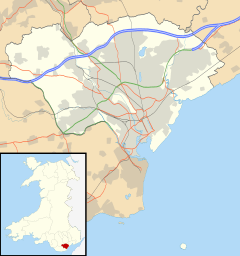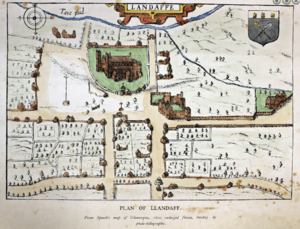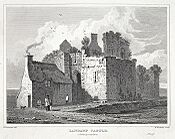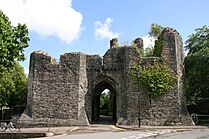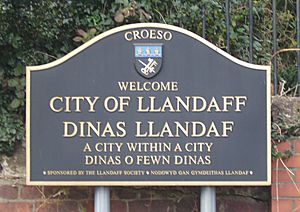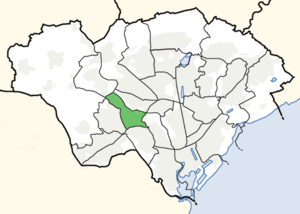Llandaff facts for kids
Quick facts for kids Llandaff
|
|
|---|---|
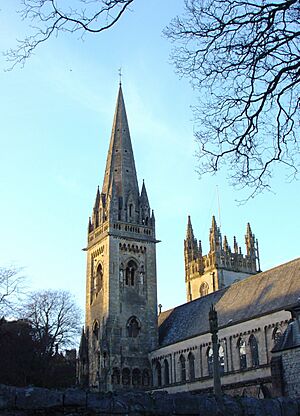 Llandaff Cathedral |
|
| Population | 8,997 (2011) |
| Community |
|
| Principal area | |
| Ceremonial county | |
| Country | Wales |
| Sovereign state | United Kingdom |
| Post town | CARDIFF |
| Postcode district | CF5 |
| Dialling code | 029 |
| Police | South Wales |
| Fire | South Wales |
| Ambulance | Welsh |
| EU Parliament | Wales |
| UK Parliament |
|
Llandaff (pronounced Lan-daff) is a historic area in the north of Cardiff, the capital city of Wales. Its Welsh name, Llandaf, comes from llan (meaning 'church') and Taf (the name of the River Taff). Llandaff became part of Cardiff in 1922.
It is a very important religious place because it is home to the Bishop of Llandaff. The Bishop leads a large church area called a diocese within the Church in Wales. This diocese covers many people in Wales.
Contents
History of Llandaff
The history of Llandaff is mostly about its role as a religious site. People started worshipping here as early as the 6th century AD. This was probably because it was the first solid ground north of where the River Taff met the Bristol Channel. It was also an old crossing point on a north-south trade route.
Some parts of the Llandaff Cathedral building date back to the 12th century. For example, the impressive Urban Arch is named after Bishop Urban from that time. The cathedral has been destroyed and rebuilt many times. This happened because of wars, neglect, and natural disasters.
Llandaff was badly attacked by Owain Glyndŵr in the 15th century and by Oliver Cromwell in the 17th century. During World War II, it was the second most damaged cathedral in the UK. It was hit by bombs from the Luftwaffe (German air force). After the war, George Pace, an architect, helped restore it.
One of the most famous parts of the modern cathedral is the Christ in Majesty statue. This large aluminium figure was made by Jacob Epstein in the 1950s. It hangs above the main part of the church, called the nave. In 2007, lightning struck the spire, which destroyed the organ. A new, very large organ was installed in 2010.
(Llandaff Castle or Bishop's Castle)
The Bishop's Palace is a ruined castle near the cathedral. It is also known as Llandaff Castle. It was likely built around the same time as Caerphilly Castle, in the late 1200s. People believe it was left empty after Owain Glyndŵr attacked it in the 1400s. Today, the gatehouse of the Palace still stands, and its courtyard is a public garden.
Llandaff was never officially made a 'borough' (a type of town with special rights). By the 1800s, it was described as a "mere village." It had only two short streets of small houses.
Because it was the home of the Bishop, Llandaff was often called a 'city' informally. However, this city status was never officially recognized. This was mainly because it didn't have a special document called a charter. The old area of Llandaff was very large. It included places like Canton, Ely, Fairwater, and Gabalfa.
As the South Wales coalfield and Cardiff Docks grew, Llandaff slowly became part of the larger Cardiff area. Many wealthy business people and coal merchants chose to live in Llandaff. They liked it because it was a clean, green, village-like place close to the fast-growing city. Insole Court, a famous house in Llandaff, was first built in 1856.
People and Language
At the 2011 census, Llandaff had 8,997 people living there. About 91.6% of them were from various white ethnic backgrounds. Around 65% of the people were Christian. About 1.5% were Hindu, and 1.5% were Muslim. The rest had no religion or did not state one.
Welsh Language in Llandaff
In the 2011 census, 15.3% of people over three years old in Llandaff could speak Welsh. This was 1,337 people. This was a small decrease from the 2001 census, where 15.4% spoke Welsh.
Broadcasting House in Llandaff used to be the main office for BBC Cymru Wales. They moved to a new building in Cardiff city centre between 2019 and 2020.
Research shows that the Welsh language was very strong in Llandaff in the past. In the 17th century, Welsh was the main language spoken on the streets of Llandaff.
How Llandaff is Governed
Llandaff is both an electoral ward and a community within the City of Cardiff. An electoral ward is an area that elects people to represent it. There is no local community council for Llandaff.
The Llandaff electoral ward is next to other areas like Radyr & Morganstown to the north west, Llandaff North to the north, Riverside to the south east, Canton to the south, and Fairwater to the west.
Llandaff is represented by two councillors on the Cardiff Council. They are Sean Driscoll (from the Conservative Party) and Peter Huw Jenkins (from the Labour Party). These councillors help make decisions for the local area.
In the UK Parliament, Llandaff is part of the Cardiff West area. Famous Members of Parliament (MPs) from this area include George Thomas, who was once the Speaker of the House of Commons. Another was Rhodri Morgan, who used to be the First Minister of Wales. The current MP is Kevin Brennan from the Labour Party, elected in 2001.
In the Senedd (the Welsh Parliament), Llandaff is also part of the Cardiff West area. The Member of the Senedd (MS) since 2011 is Mark Drakeford from Labour. He took over from Rhodri Morgan. This area is part of the larger South Wales Central region.
Education in Llandaff
Llandaff has many schools and colleges:
Higher Education
- Cardiff Metropolitan University, Llandaff campus
- St. Michael's College, an Anglican college for religious studies
State Secondary Schools
- Bishop of Llandaff Church in Wales High School, a comprehensive school teaching in English.
- Ysgol Gyfun Gymraeg Glantaf, a Welsh-medium school (located in Llandaff North, but serves Llandaff).
State Primary Schools
- Danescourt Primary School, teaching in English.
- Llandaff City Church in Wales Primary School, teaching in English.
- Ysgol Pencae, a Welsh-medium school.
Independent Schools
- The Cathedral School, for boys and girls aged 3–18, teaching in English.
- Howell's School, for girls aged 3–18, with a mixed sixth form, teaching in English.
Getting Around Llandaff
Llandaff has several railway stations nearby: Danescourt, Fairwater, and Waun-Gron Park. Each is about a mile from the cathedral. Trains run every half hour to and from Cardiff on the Cardiff City Line. The main Llandaf railway station is actually in Llandaff North.
Cardiff Bus services also run through Llandaff. These include routes 1/2, 24/25, 62/63, 64/65, and 66. Stagecoach service 122 also operates here. These buses connect Llandaff to Cardiff city centre and other areas.
The Western Avenue (A48) runs through the south of Llandaff. It goes east towards Gabalfa and the M4 motorway (Junction 29). Westbound, it leads to Ely, Culverhouse Cross, and M4 Junction 33. Cardiff Road goes south towards the city centre.
What People Do for Work
The main types of jobs in Llandaff are:
- Education (16.2%)
- Health and social work (13.8%)
- Shops and vehicle repair (11.3%)
- Public administration and defence (9.6%)
- Professional, scientific, and technical jobs (8.9%)
- Other services (6.2%)
- Construction (6.1%)
- Information and communication (5.6%)
- Banking, finance, and insurance (5.3%)
- Hotels and restaurants (4.3%)
- Manufacturing (4%)
Broadcasting House, which was the main office for BBC Cymru Wales, opened in Llandaff in 1966. However, BBC Cymru Wales moved to new buildings in Cardiff city centre in 2020. The old Llandaff site is now planned to be used for housing.
Llandaff and Doctor Who
The popular science-fiction TV show Doctor Who was produced by BBC Wales in Llandaff after it returned to TV in 2005. The show's production later moved to new studios in Cardiff Bay in 2012.
Some outdoor scenes for four Doctor Who episodes were filmed in Llandaff:
- "Human Nature" (2007)
- "The Family of Blood" (2007)
- "The Eleventh Hour" (2010)
- "Vincent and the Doctor" (2010)
Famous People from Llandaff

Many notable people have connections to Llandaff:
- Sir Ivor Atkins (1869–1953), a choirmaster and organist, was born here.
- James Dean Bradfield (born 1969), singer and guitarist for the band Manic Street Preachers.
- Charlotte Church (born 1986), a singer and TV presenter, was born in Llandaff and went to Howell's School.
- Roald Dahl (1916–1990), the famous author, was born in Llandaff and attended the Cathedral School. He famously played a trick on a sweet shop owner here!
- Cheryl Gillan (1952–2021), who was the Secretary of State for Wales, was born in Llandaff.
- Francis Lewis (1713–1802), one of the people who signed the United States Declaration of Independence.
- Sir David Mathew (1400–1484), a brave soldier who fought in the Battle of Towton. He saved King Edward IV's life and his tomb is in Llandaff Cathedral.
- Terry Nation (1930−1997), a TV writer who wrote many Doctor Who episodes and created the Daleks. He also created the BBC series Blake's 7.
- Ivor Williams (1908–1982), an artist who lived and painted in Llandaff.
See also
 In Spanish: Llandaff para niños
In Spanish: Llandaff para niños


